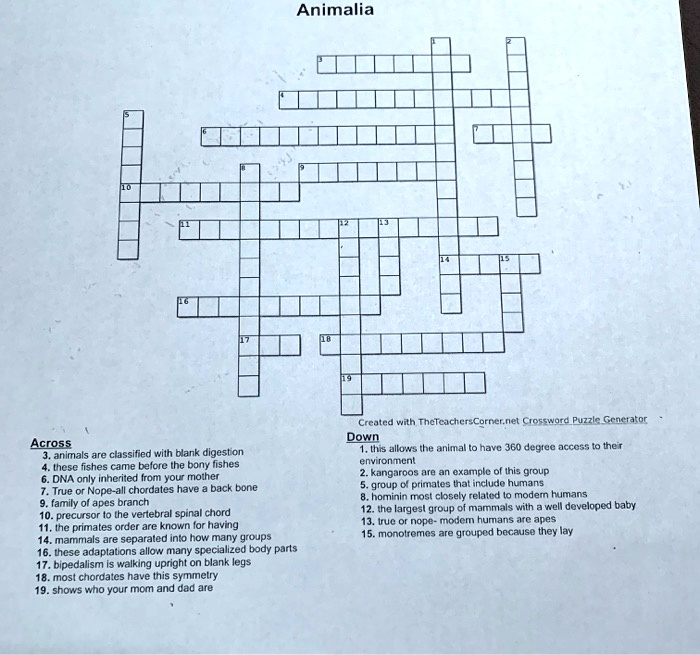All the animals have 360 degrees of access to their environment. 4. Kangaroos are an example of this group. 6. Primates that include humans. 7. Hominins are most closely related to modern humans. 9. The largest group of mammals. 10. Well-developed baby pouches. 12. Monotremes are grouped together because they lay eggs. Down 2. Animals are classified with a blank digest. 3. These fishes came before the bony fishes. 5. DNA only inherited from your mother. 8. All chordates have a backbone. 11. The vertebral spinal cord. 13. The primates order is known for having these adaptations. 14. Mammals are separated into how many groups? 15. These adaptations allow for specialized body parts. 17. Bipedalism – walking upright on blank legs. 18. Most chordates have this symmetry. 19. Shows who your mom and dad are.
Animalia Created With Encyclopaedia Britannica Crossword Puzzle Generator Across 1. All the animals have 360 degrees of access to their environment. 4. Kangaroos are an example of this group. 6. Primates that include humans. 7. Hominins are most closely related to modern humans. 9. The largest group of mammals. 10. Well-developed baby pouches. 12. Monotremes are grouped together because they lay eggs. Down 2. Animals are classified with a blank digest. 3. These fishes came before the bony fishes. 5. DNA only inherited from your mother. 8. All chordates have a backbone. 11. The vertebral spinal cord. 13. The primates order is known for having these adaptations. 14. Mammals are separated into how many groups? 15. These adaptations allow for specialized body parts. 17. Bipedalism – walking upright on blank legs. 18. Most chordates have this symmetry. 19. Shows who your mom and dad are

The Correct Answer and Explanation is:
Across
- Eyes
- Marsupial
- Hominids
- Chimpanzees
- Rodents
- Pouch
- Eggs
Down
- Complete
- Jawless
- Mitochondria
- True
- Notochord
- Grasping
- Three
- Segmentation
- Two
- Bilateral
- Pedigree
This crossword touches on essential themes in zoology and evolutionary biology. For example, marsupials like kangaroos are notable for their pouches and are distinct from placental mammals. They’re one of three major mammal groups, the others being monotremes, which lay eggs, and placentals, which have a well-developed placenta.
Rodents form the largest mammalian group, accounting for over forty percent of mammalian species. Their success lies in their adaptability and reproductive efficiency.
Primates, including hominids, are known for traits like grasping hands, forward-facing eyes, and complex brains. Within hominids, chimpanzees are our closest living relatives, sharing a high percentage of DNA and exhibiting tool use, problem solving, and social behavior.
An interesting genetic detail lies in mitochondrial DNA, which is inherited maternally and helps trace maternal ancestry. Similarly, a pedigree chart tracks family lineage.
From a structural standpoint, notochords are a hallmark of chordates and represent the early development of the spinal column. Bilateral symmetry is another shared feature of most animals, allowing for efficient movement and sensory coordination.
Lastly, terms like complete digestion and segmentation speak to the physiological and anatomical adaptations that define complex animals. Segmentation, as seen in earthworms and arthropods, enables specialization of body regions for specific tasks.
